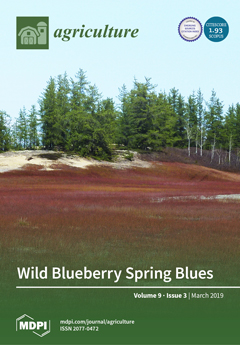Heterogeneity in pineapple fruit quality explains the low export volume of fruits from Benin to the international market. This work aims to investigate influences of organo-mineral fertilizer on a) pineapple fruit yield, b) fruit quality and the proportion of fruits meeting European export
[...] Read more.
Heterogeneity in pineapple fruit quality explains the low export volume of fruits from Benin to the international market. This work aims to investigate influences of organo-mineral fertilizer on a) pineapple fruit yield, b) fruit quality and the proportion of fruits meeting European export standards, and c) fresh fruit acceptability for domestic consumption. The experimental design is a split-plot with three replications where the main factor is organic manure (poultry litter) (P0 = 0 t ha
−1, P1 = 5 t ha
−1, P2 = 10 t ha
−1) and the sub-plot factor, N-P-K fertilization in kg ha
−1 (T0:100-30-150, T1: 200-60-300, T2: 400-120-600, and T3: 600-180-900). To evaluate the percentage of fruit meeting European standards, a generalized linear model with binomial error structures was used. A sensorial test was carried out on fresh pulp to assess the preference of fruit meeting domestic criterion. A preference mapping was assessed through an acceptability test with a nine-point hedonic scale. Organo-mineral fertilizer significantly improved fruit weight (
p = 0.012), fresh juice weight (
p = 0.042), total soluble solids (
p = 0.032), and the percentage of fruits meeting European standards (
p < 0.001). Better fruits meeting export standards were found with treatments P1T1, P2T0, and P2T3 (83.33 ± 28.87%). Fruits from treatments P0T2, P2T1, P1T3, and P2T2 were highly accepted for domestic consumption (70%). The results suggested that organo-fertilizer producing fruit achieving exportation standards may differ from those satisfying domestic preferences. Moreover, the findings suggested that the ratio crown length: fruit length, which is a key ratio for exportation standards, is not related to physico-chemical quality. Finally, the findings have implications for the sustainability of pineapple production for domestic and exportation purposes.
Full article





